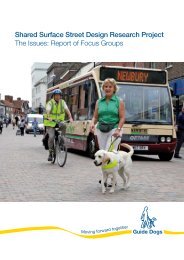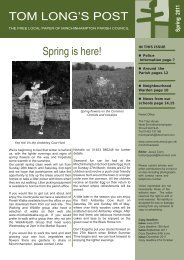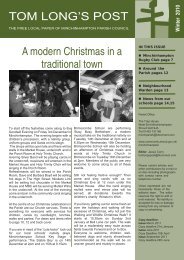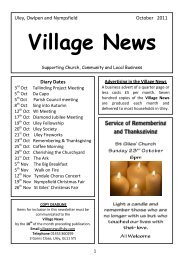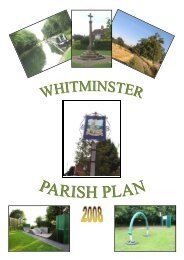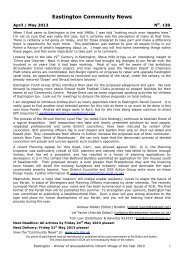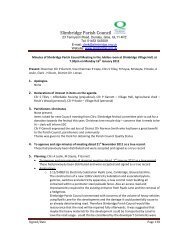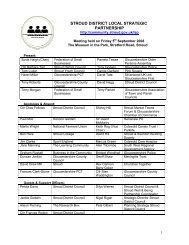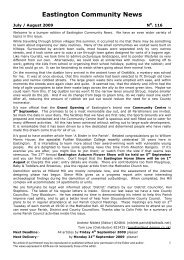An Historical Introduction to Minchinhampton
An Historical Introduction to Minchinhampton
An Historical Introduction to Minchinhampton
You also want an ePaper? Increase the reach of your titles
YUMPU automatically turns print PDFs into web optimized ePapers that Google loves.
The conditions were such that many people were tempted <strong>to</strong> try <strong>to</strong> gain a better life abroad andbetween 1839 and 1842 nearly fifty Minchinhamp<strong>to</strong>n weavers emigrated. A century previously theresponsibility of caring for the poor, levying a poor rate and the repair of the highways were laidupon local vestries. These developed from parish meetings, which consisted of all the male churchmembers who met once a year <strong>to</strong> elect churchwardens. The ecclesiastical work of the vestry hadbecome submerged in the concerns of the <strong>to</strong>wn and tithing, the rural neighbourhood, and themeetings usually consisted of a few men who were concerned with a particular issue, but the namewas retained. However, even though unelected, the Minchinhamp<strong>to</strong>n Vestry carried outconsiderable improvement work in the C19 th including the provision of a fire engine, lock-up, gaslighting and purchasing one of the cottages in the churchyard for the Sunday School and for vestrymeetings, which had previously been held in the upper room of The Crown opposite. When theelected Parish Council replaced the Minchinhamp<strong>to</strong>n Vestry at the centre of local affairs in 1894, it<strong>to</strong>ok over the property and the council has met there ever since, making it the centre of localgovernment for over a century and a half.The site of the old manor house had been sold during the Napoleonic Wars, and in the 1820s acertain William Whitehead conceived the idea of building himself a mansion, <strong>to</strong> be calledMinchinhamp<strong>to</strong>n Abbey, on its site. Foundations were laid, the walled garden set out, but hemanaged <strong>to</strong> lose a fortune at the gaming tables and the land was sold <strong>to</strong> David Ricardo, thuscompleting the circle of ownership. It was the Ricardo family who donated the land on which thefirst Minchinhamp<strong>to</strong>n Schools were built in 1868, having established a school in the Market Housefifty years earlier. The present school is the third on the site, the last one having survived just thirtyyears from 1968. In Bell Lane, so called not for the church bells but from an inn that s<strong>to</strong>od there, isthe Master’s House, built at the same time as the original school.Throughout the Vic<strong>to</strong>rian period conditions for the inhabitants of Minchinhamp<strong>to</strong>n graduallyimproved. The remaining stretches of open fields had been enclosed and many farms requiredlabour, especially <strong>to</strong> the east of the <strong>to</strong>wn. Many women found work in the spinning mills of thevalleys, and their menfolk accepted employment on the power looms. Other mills made walkingsticks and umbrella frames, and new engineering industries could be found at Brimscombe, Thruppand Nailsworth. The small cottages in West End, Tetbury Street and lower Butt Street becamehome <strong>to</strong> larger families, as more children survived infancy, and vegetables from the garden, where afew chickens and possibly a pig would be kept, supplemented the diet. Just below the spring thatgave Well Hill its name is King Street; this was once the poor end of <strong>to</strong>wn and the row of cottageshas date s<strong>to</strong>nes, more recent as you ascend the hill. Spanning the lane are three bridges, probablymade because this was an ancient right of way and pedestrians could use it without seeing thegrounds of the Lammas, and themselves being invisible from the house! The path emerges oppositePark Terrace, or The Buildings. These cottages date from 1833 and were originally for the workerson the Gatcombe estate. There is a s<strong>to</strong>ry that soon after Park Terrace was built, a member of theRicardo family passed in a carriage and saw washing hanging in front of the cottages, as this wasthe only garden for the tenants at that time. The sight so offended the sensibilities that rear gardenswere provided for each cottage!



